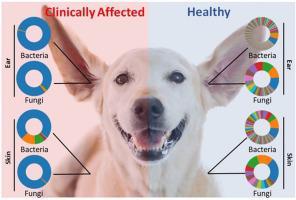Veterinary Microbiology ( IF 2.4 ) Pub Date : 2020-06-17 , DOI: 10.1016/j.vetmic.2020.108764 Shuiquan Tang 1 , Aishani Prem 2 , Joshua Tjokrosurjo 2 , Mony Sary 2 , Mikayla A Van Bel 3 , Aline Rodrigues-Hoffmann 4 , Michael Kavanagh 5 , Guangxi Wu 2 , Marc E Van Eden 1 , Janina A Krumbeck 1

|
This study analyzed the complex bacterial and fungal microbiota of healthy and clinically affected canine ear and skin samples. A total of 589 canine samples were included: 257 ear swab samples (128 healthy vs. 129 clinically affected) and 332 skin swab samples (172 healthy vs. 160 clinically affected) were analyzed using next-generation sequencing (NGS) to determine both relative and absolute abundances of bacteria and fungi present in the samples. This study highlighted the canine microbiota of clinically affected cases was characterized by an overall loss of microbial diversity, high microbial biomass, with overgrowth of certain members of the microbiota. The observed phenotype of these samples was best described by the combination of both relative and absolute microbial abundances. Compared to healthy samples, 78.3% of the clinically affected ear samples had microbial overgrowth; 69.8% bacterial overgrowth, 16.3% fungal overgrowth, and 7.0% had both bacterial and fungal overgrowth. The most important microbial taxa enriched in clinically affected ears were Malassezia pachydermatis, Staphylococcus pseudintermedius, Staphylococcus schleiferi, and a few anaerobic bacteria such as Finegoldia magna, Peptostreptococcus canis, and Porphyromonas cangingivalis. The anaerobic microbes identified here were previously not commonly recognized as pathogens in canine ear infections. Similar observations were found for skin samples, but yeasts and anaerobes were less abundant when compared to clinically affected cases.
Results highlighted herein, signify the potential of NGS-based methods for the accurate quantification and identification of bacterial and fungal populations in diagnosing canine skin and ear infections, and highlight the limitations of traditional culture-based testing.
中文翻译:

犬皮肤和耳朵微生物组:使用一种基于下一代测序的新型检测方法,对涉及犬皮肤和耳朵感染的病原体进行了全面调查。
这项研究分析了健康且受到临床影响的犬耳和皮肤样本的复杂细菌和真菌微生物群。总共包括589个犬样本:使用下一代测序(NGS)分析了257个耳拭样本(128个健康对120个临床受影响的样本)和332个皮肤拭子样本(172个健康对临床的160个样本)进行分析,以确定相对样品中细菌和真菌的绝对丰度。这项研究强调了临床感染病例的犬微生物群,其特征是微生物多样性总体丧失,微生物生物量高,某些微生物群成员过度生长。这些样品的观察到的表型最好是通过相对和绝对微生物丰度的组合来描述的。与健康样本相比,为78。受临床影响的耳朵样本中有3%有微生物过度生长;69.8%的细菌过度生长,16.3%的真菌过度生长和7.0%的细菌和真菌过度生长。富含临床受影响的耳朵的最重要的微生物分类是马拉色菌(Marassezia pachydermatis),伪葡萄球菌(Staphylococcus pseudintermedius),schleiferi葡萄球菌(Staphylococcus schleiferi)和一些厌氧细菌,例如大白菜(Finegoldia magna),犬链球菌(Peptostreptococcus canis)和猪牙菌(Porphyromonas cangingivalis)。在这里确定的厌氧微生物以前在犬耳感染中通常不被认为是病原体。对于皮肤样品也发现了类似的观察结果,但是与临床上受影响的病例相比,酵母和厌氧菌的含量较低。
本文重点介绍的结果表明,基于NGS的方法在诊断犬皮肤和耳朵感染中准确定量和鉴定细菌和真菌种群的潜力,并突出了传统基于培养的测试的局限性。











































 京公网安备 11010802027423号
京公网安备 11010802027423号